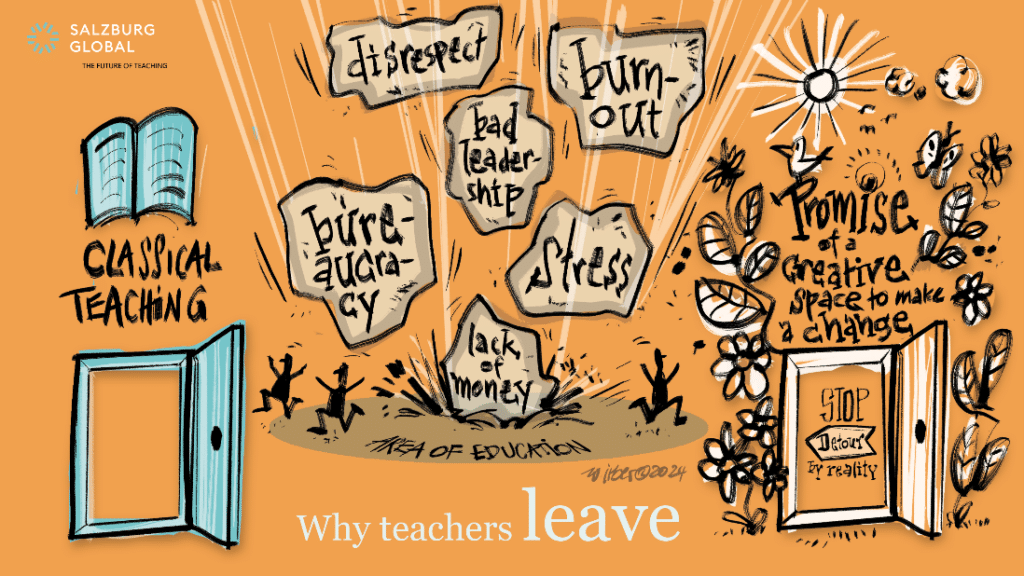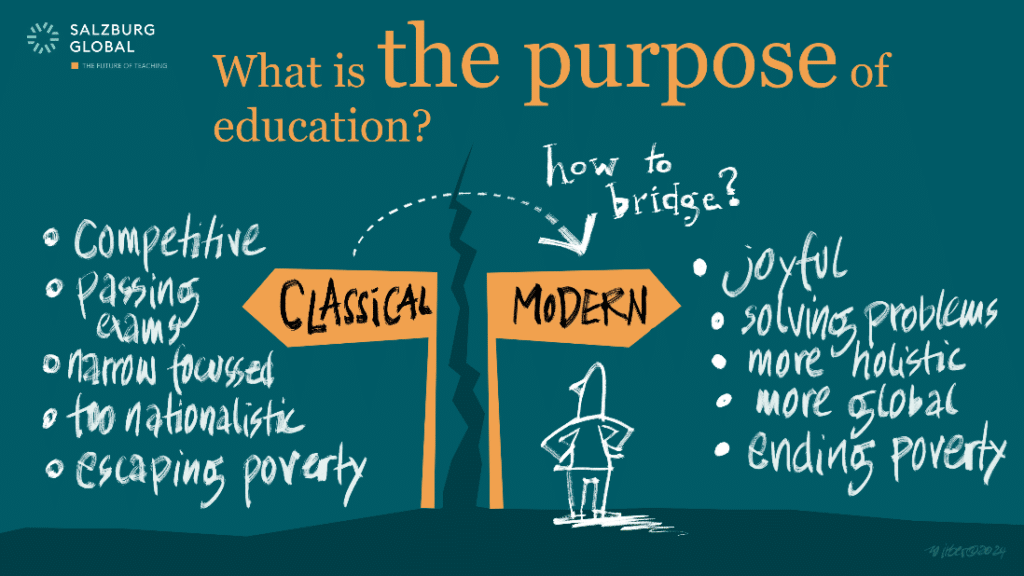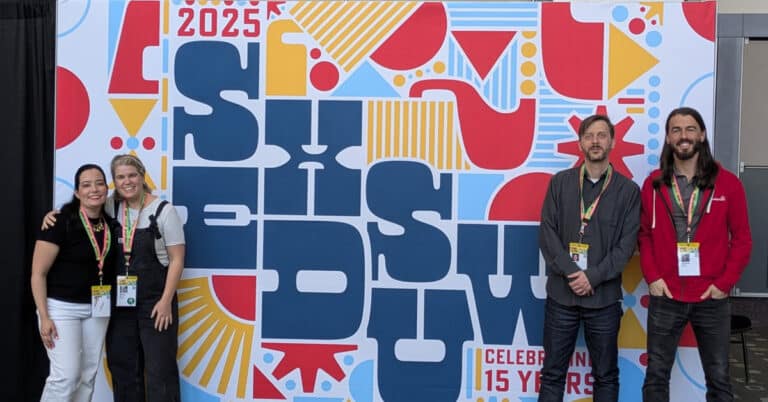People around the world are considering possibilities for the future of teaching. In many places, significant teacher shortages are challenging the ability of education systems and schools to operate optimally. At the same time, many people seem eager to reimagine education models and, with them, what it means to support learning.
A recent Salzburg Global seminar on the future of teaching surfaced a variety of reasons why teachers have been leaving the profession, as shown below.

Teacher shortages are widespread. In the U.S., one in eight teaching positions is unfilled or filled by teachers who are not fully certified for their assignments. In India, there are over one million teacher vacancies, with the most in rural and underserved areas. Nigeria faces an acute shortage, with fewer than 4,000 skilled and technical teachers nationwide. In the United Kingdom, too few secondary school teachers are being recruited, especially in key subjects. Mexico also faces a worsening shortage of teachers.
People around the world are leaving the teaching profession or not considering it in the first place. In addition, artificial intelligence (AI) and other accelerating technologies are combining with other drivers of change to shift the landscape within which teaching and learning occur. AI is creating new opportunities for how educators design learning experiences and spend their time, even as it deepens concerns about digital equity, privacy and security.
As KnowledgeWorks explored in Envisioning Educator Roles for Transformation, the time is ripe to think creatively about what might be possible for the future of learning and the future education workforce. Might a learning spark facilitator focus on modeling engagement with learning or a partnership navigator link a school with its community to provide students with real-world experiences? Such roles could help make education more equitable and learner-centered and improve educators’ working conditions.
The question of purpose
A key factor in considering such possibilities for the future of teaching is to clarify what purpose(s) education systems and schools seek to pursue. Their stated and enacted purposes determine the outcomes for which they aim and shape the mindsets that people bring into learning environments. Purpose can also drive how education systems and schools are structured and what jobs the people working in them hold. Big Change identified it as one of three drivers to transform education systems alongside power and practice.
Looking ahead, will we keep orienting education around closing achievement gaps and scoring well on assessments of core knowledge and skills, or might we shift its purpose to focus on growing students as leaders of a better future? The image below from the Salzburg Global seminar on the future of teaching illustrates this crossroads.

There are many possible purposes of education, and they vary by context. Teach For All has collected perspectives on the question of purpose – plus who decides and how – from transformational teachers around the world. The answers to this question could help government agencies, educators and others unravel the tricky problem of teacher shortages.
Widening the aperture
What if we stopped asking, “How might we attract and retain more teachers as we know them today?” and instead asked, “What structures and roles might best support learning given our aims and our hopes for young people?”
Teachers could come to be defined as tour guides. Out-of-school educators could play a more central role. Community elders could be recognized as educators. AI agents could carry out administrative tasks and some assessment, freeing up human educators to focus on cultivating relationships and high-level understanding.
Exploration of how we might expand and augment what it means to be a teacher is underway. In fostering community-engaged learning, CommunityShare has been connecting school-based educators and learners with community partners who can help them realize their goals. Education Reimagined has been exploring the potential for learning ecosystems to embed learners in cross-functional teams that support their growth and development. Arizona State University’s Next Education Workforce initiative has been supporting school districts in implementing team-based staffing models to help both teachers and students thrive. TeachAI has been offering guidance for schools on AI’s potential benefits and risks, including its potential to support teacher instruction and quality of life.
Expanding the range of roles considered to be educators – or to support young people in learning – and reconsidering how education systems and schools construct and support current teaching roles could attract more people. It could also inspire fresh thinking about how supporting learning, if only part-time, might fit into a person’s career and life. As the education landscape diversifies over the next decade, adults could have more choice about how they contribute to education. Young people could also have more agency over what, when and how they learn.
Today, people working toward education transformation or simply trying to address the teacher shortage have an opportunity to widen the aperture when considering how best to support learning in different learning environments, including schools. We need to keep challenging our assumptions about where learning happens, what learning counts and what purpose education systems and schools are aiming to serve. Maybe today’s teacher shortages are symptoms of a waning paradigm for learning, and education leaders and advocates need to engage in deep design work to discover better ways of organizing and staffing for the new era that is emerging.






